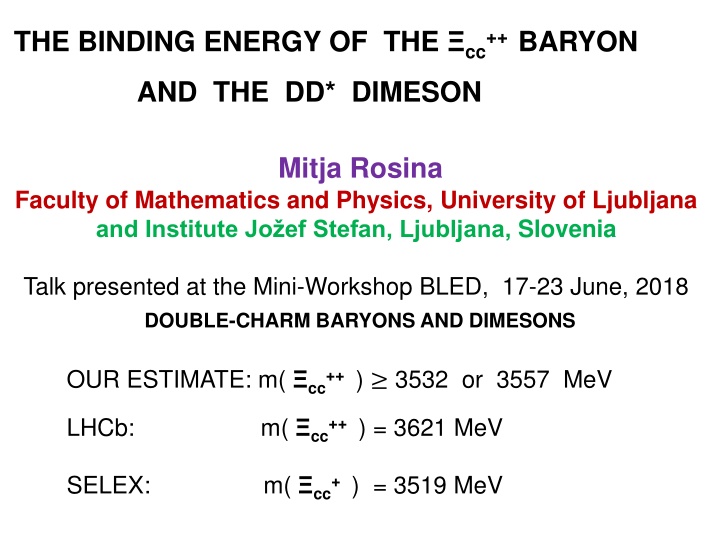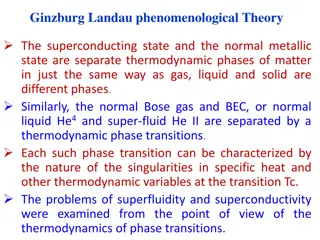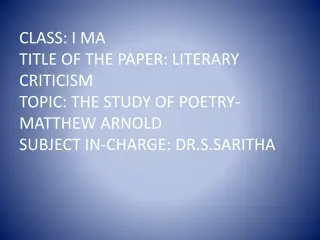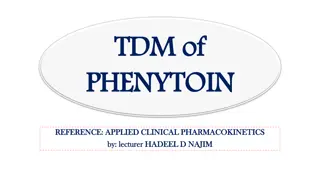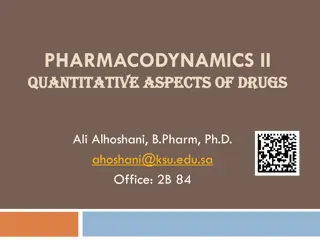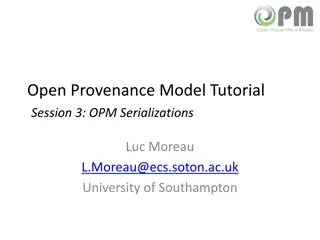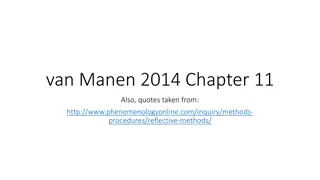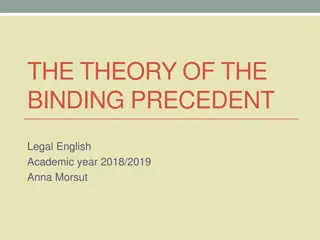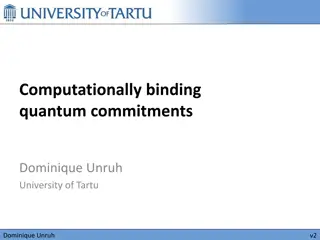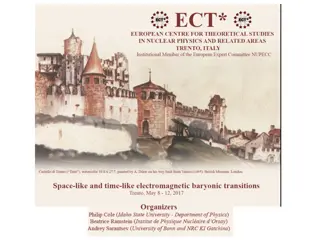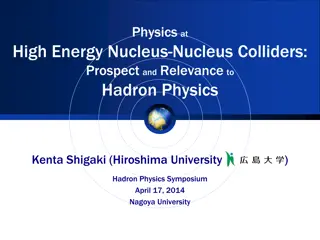Phenomenological Estimate of the cc++ Baryon Binding Energy
The binding energy of the cc++ baryon and the DD* dimeson is estimated and compared with experimental values in this study. The mass estimations based on various decay channels and theoretical calculations provide insights into these unique particles. Important questions regarding binding interactions and pion clouds in DD* molecules are raised.
Download Presentation

Please find below an Image/Link to download the presentation.
The content on the website is provided AS IS for your information and personal use only. It may not be sold, licensed, or shared on other websites without obtaining consent from the author.If you encounter any issues during the download, it is possible that the publisher has removed the file from their server.
You are allowed to download the files provided on this website for personal or commercial use, subject to the condition that they are used lawfully. All files are the property of their respective owners.
The content on the website is provided AS IS for your information and personal use only. It may not be sold, licensed, or shared on other websites without obtaining consent from the author.
E N D
Presentation Transcript
THE BINDING ENERGY OF THE cc++ BARYON AND THE DD* DIMESON Mitja Rosina Faculty of Mathematics and Physics, University of Ljubljana and Institute Jo ef Stefan, Ljubljana, Slovenia Talk presented at the Mini-Workshop BLED, 17-23 June, 2018 DOUBLE-CHARM BARYONS AND DIMESONS OUR ESTIMATE: m( cc++ ) 3532 or 3557 MeV LHCb: m( cc++ ) = 3621 MeV SELEX: m( cc+ ) = 3519 MeV
DECAY CHANNELS: c s LHCb: m( cc++ ) = 3621 MeV cc++ c+ + K- + + + + , c+ p+ K- + + ccu cud + su + ud + ud SELEX: m( cc+ ) = 3519 MeV cc+ c+ + K- + + cc+ D+ + p + K-
PHENOMENOLOGICAL ESTIMATE OF THE cc++ MASS u u u or b c c c like B+ meson (5279 3557) MeV like D0 meson (1865 3532) MeV m (c) = 1870 MeV m (b) = 5259 MeV m (cc) = 3537 MeV m (ccu) = m(D0) - m(c) + m(cc) m (ccu) = m(B+) - m(b) +m(cc) =1865-1870+3537 =3532 MeV =5279-5259+3537=3557 MeV
1 The Vqq = Vqq rule for diquark meson 2 Vcc = 1 2 Vcc [A]: (color.color)=4/3 for cc =2/3 for cc [B]: Flux tube model c c c c c
1 The Vqq = Vqq rule for diquark meson 2 ?2 2(?/2)+ ???? = Ecc? ?? ?2 2(?/4)+ ???? = Ecc? ???? = 1 2(?/2)+ 2 Ecc = F(c/2) Ecc = 1 2 F(c/4) notation: particle symbols mean their masses
The finite size of the diquark and the extra Coulomb repulsion would raise the mass a little. The estimate ( 3532 or 3557 MeV) is then not too far from the experimental value 3621 MeV. It is considerably above the SELEX value 3519 MeV, but it does not exclude it.
BINDING ENERGY OF THE DD* MOLECULE The nonrelativistic calculation of Janc & Rosina (2004) Used the one-gluon exchange potential (including the chromomagnetic term) + the linear confining potential. The model parameters fitted all relevant mesons and baryons. Janc & Rosina : (DD*) (D + D*) = - 0.6 MeV (Bhaduri ) - 2.7 MeV (Grenoble AL1) Important questions: 1. How much is binding for other interactions? 2. Can the pion cloud between the u and d antiquarks (the DD* or DD* configuration) increase binding ? 3. How much does relativity change binding?
MOTIVATION 1. Effective quark-quark interaction: Is Vuu = Vcu = Vcc = Vcc = Vbu = Vbb = Vbb (apart from the mass-dependent spin-spin term) ? 2. Interesting 4-body problem, to understand binding and to forsee the production and detection mechanisms. CHALLENGE: New chances to measure BB*=(bu+bd) @ LHC and DD*=(cu+cd) at the upgraded Belle-2 @ KEK (Tsukuba, Japan).
COMPARISON BETWEEN DIMESON AND HYDROGEN MOLECULE POTENTIAL V rcc u cc D + D* c c c d
PHENOMENOLOGICAL ESTIMATE OF DIMESON BINDING u u b u bb b b b d d d Dimeson B+B* (5279+5325=10604)MeV like b antibaryon (5620 10476)MeV Tetraquark u u u c c c cc c d d d like c antibaryon (2286 3967)MeV Dimeson D+D* (1867+2008=3875)MeV Tetraquark
Is the D+D* dimeson bound? In the restricted 4-body space assuming "cc" in a bound diquark state + general wavefunction of u and d, the energy is above the D+D* threshold. In the restricted "molecular" 4-body space assuming the two c quarks far apart + general wavefunction of ubar and dbar (as assumed by several authors), the energy is also above the D+D* threshold. Only combining both spaces (we took a rich 4-body space) brings the energy below the threshold.
The nonrelativistic calculation of Janc & Rosina (2004) Used the one-gluon exchange potential (including the chromomagnetic term) + the linear confining potential. The model parameters fitted all relevant mesons and baryons. A rich 4-body space was used (an s-state Gaussian expansion at optimized distances, with 3 types of Jacobi coordinates in order to mimic also the p-states). (DD*) (D + D*) = - 0.6 MeV (Bhaduri ) - 2.7 MeV (Grenoble AL1) Can the pion cloud between the u and d antiquarks increase binding, in analogy with the deuteron ? At a distance of 0.5 fm the two-pion-exchange interaction between the D and D* mesons might bring additional 50 MeV??
A note on analogy between DD* and DD* We failed to calculate the energy of X(3872) using the same method and interaction as for DD*, [Bled Proceedings 2005]. The reason is that a perfect variational calculation in a rather complete 4-body space finds the absolute minimum of energy which correspnds to J/psi+eta rather than DD*. A demanding coupled channel calculation would be needed for a reliable result, and we have posponed it.
